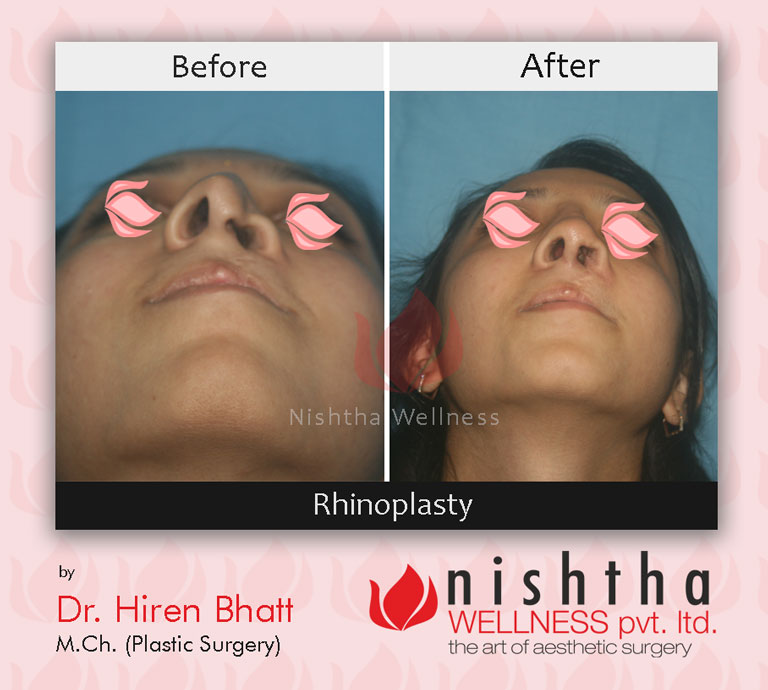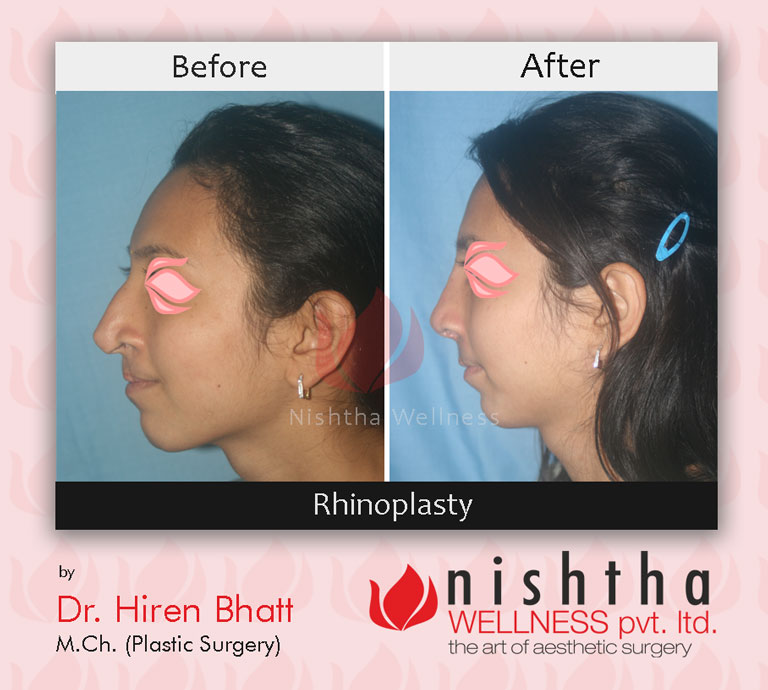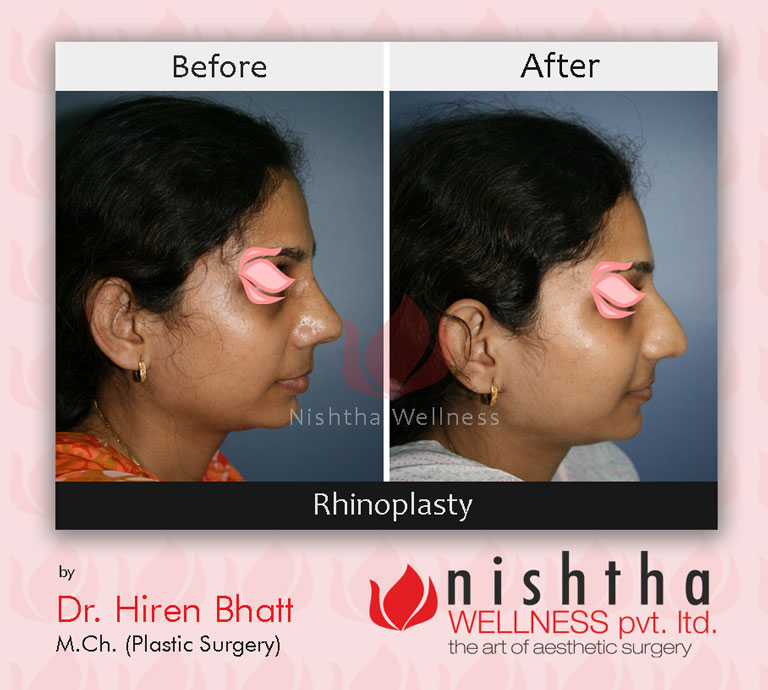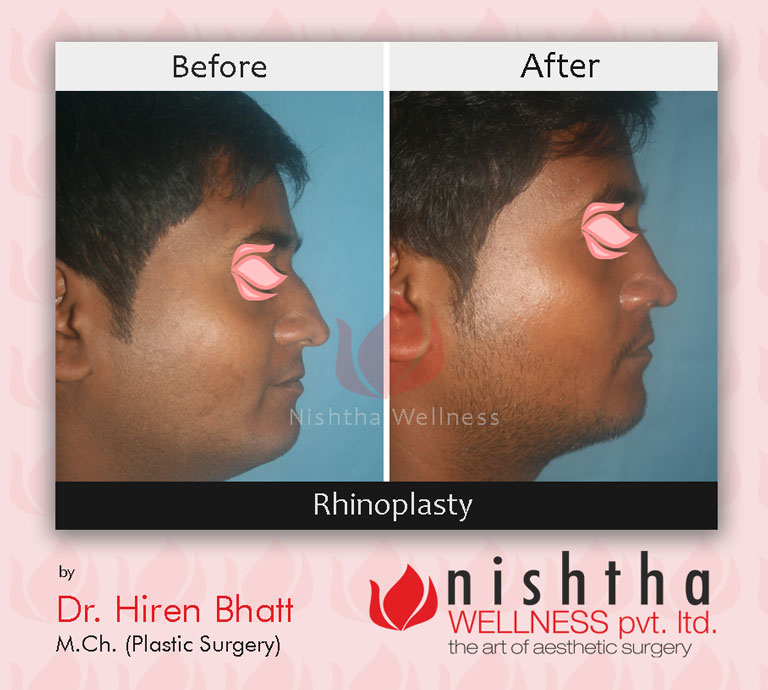FAQ's
What is Rhinoplasty?
Rhinoplasty is commonly referred to as nose surgery or even “nose job”. Dr. Hiren Bhatt, the accredited Plastic Surgeon explains that Rhinoplasty is performed in order to change the size and appearance of the nose, along with improving any pre-existing functional flaws that accompany a deformed nose. Sometimes in certain unique scenarios at NVYA Aesthetics, Vadodara, the goal of a Rhinoplasty could be to repair any damage caused to the nose due to an accident or injury. Understanding the anatomy of the nose is vital when we discuss rhinoplasty. The upper part of the nose is made up of bone and the lower part of cartilage. Rhinoplasty involves altering the bone, cartilage and skin either individually or all together in order to have good and natural-looking results.
Why Do Patients Opt For Rhinoplasty?
There are many issues with the nose that can be easily corrected with the help of a Rhinoplasty at NVYA Aesthetics, Vadodara. Nose Surgery is one of the safest Plastic Surgeries and the results are permanent.
Dr. Hiren Bhatt sets forth all the issues (anatomical and medical) that a Rhinoplasty can correct effectively, these are the reasons why patients opt for the surgery:
-
Humps and Depressions: Sometimes, there are humps and depressions on the bridge of the nose. These may or may not be visible from the frontal side, however, are clearly detectable when viewed from the side.
-
Nasal Tip: The nasal tip may be too rounded, too thin or have a droopy look where it does not make a 90-degree angle with the upper lip which gives the appearance of a hooked nose.
-
Nostrils: The nostrils may be too wide or upturned which affects the overall appearance of the face.
-
Nose size: In certain cases, the nose size might not be proportionate with the other facial features.
-
Deviated Septum: A deviated septum leads to breathing issues. The septum is part of the flesh that separates the nasal cavities.
-
Damage to the nose due to injury: In case of trauma to the nose, or an injury to the nose due to an accident, the bone or the cartilage may be harmed. This needs to be corrected in order to restore the nose to its original shape.
Based on the above mentioned medical issues, there are different types of Rhinoplasties. They are as follows:
-
Reduction Rhinoplasty: It makes a prominent, big nose more symmetrical and softer looking.
-
Augmentation Rhinoplasty (Nose Implant): It increases the projection of a flat or depressed nose.
-
Tip Surgery: It refines the tip and makes it sharper.
-
Reducing The Nostrils: Adjusting the nostril size to be in proportion with the nose and the rest of the face.
-
Correction Of A Deviated Septum: Septum is the curtain-like structure between two sides of the nose. A Deviated Septum can create functional problems. this can be tackled by a procedure called septorhinoplasty.
Dr. Hiren Bhatt’s expertise in Plastic Surgery helps patients in correcting any of the above issues with Rhinoplasty.
What Are The Different Methods Of Performing A Rhinoplasty?
There are three different methods to perform nose surgery. The choice of the method is decided by Dr. Hiren Bhatt after the physical examination of the patient and after understanding the desires of the patient.
-
Open Rhinoplasty: A small incision is made in the columella, which connects all the relevant parts of the nose to be corrected. The nasal tip is then folded upwards in order to open the nose. This is an open surgery, hence there is direct access to nasal passage airways making it easy to operate and correct the imperfections.
-
Closed Rhinoplasty: In a closed rhinoplasty, the incisions are made within the nostrils, hence there is no scarring. There is restricted tissue dissection and difficult nasal visualization.
-
Septoplasty: This surgery aims at correcting a deviated septum that obstructs the nasal air passage. It aims at functionally altering the nose in order to ease the breathing.
What Material Is Used For A Nose Implant In A Rhinoplasty?
Dr. Hiren Bhatt, the Board-certified Plastic Surgeon of NVYA Aesthetics, Vadodara performs a lot of Rhinoplasties which need a nose implant to increase the size or projection of the nose. Generally, there are three varieties of such augmentation materials which are used at NVYA Aesthetics, Vadodara:
- Silicone Nose Implant:
Silicone is a rubber-like synthetic material used to augment various parts of the body. The augmentation of the nose with the silicone gives the best result.
However, sometimes a patient’s body is not able to tolerate silicone as, after all, it is a ‘foreign’ material. If it so happens, according to Dr. Hiren Bhatt, an accredited Plastic Surgeon the silicone can be removed and the nose then returns to what it was before. The nose then can be augmented by the other two methods.
- Bone Nose Implant:
Here the person’s own bone is used. The bone is obtained from the skull, pelvic bone or the rib. Removal of bone from these area does not leave any defect or functional deficit.
The disadvantage of putting the bone is that it gets smaller because of absorption. Hence after some time, the augmentation is lost in variable degrees. If bone from the skull is used, it gives the best result and the absorption is either absent or minimal. Taking the bone from the skull is however technically more demanding for the surgeon, explains Dr. Hiren Bhatt, Plastic Surgeon.
- Cartilage Nose Implant:
To explain to a layman, the cartilage can be defined as a soft bone, bone without calcium. It is found in the lower half of the nose, the septum of the nose (the curtain that separates two sides of the nose), ear and ribs.
The cartilage can be taken from all these areas. Augmentation with the cartilage is good for minor augmentation. If a major augmentation is desired, the cartilage is not a good material as it has a tendency to bend.
Some cases require correction of a deviation of the septum of the nose and improvement of the tip of the nose.
Who Is An Ideal Candidate For A Rhinoplasty?
At NVYA Aesthetics, we have set up some criteria that the patient must fit in to be an ideal candidate for Rhinoplasty.
- You are an adult with completed facial growth.
- You are a non-smoker, or ready to quit smoking for the period prescribed by Dr. Hiren Bhatt
- You are physically healthy.
- You are unhappy with the appearance of the nose.
If you fit into the above criteria then you are an ideal candidate for rhinoplasty at NVYA Aesthetics, Vadodara.
What To Expect At The Consultation With Dr. Hiren Bhatt?
Generally, when a patient comes to the office for a rhinoplasty, Dr. Hiren Bhatt will explain the surgical procedure of Rhinoplasty to the patient. The methodology is decided after taking into consideration the patient’s unique case.
Dr. Hiren Bhatt of NVYA Aesthetics, Vadodara conducts a physical examination of the patient and notes down their medical history, past surgeries (if any) and expectations from the Rhinoplasty.
Dr. Hiren Bhatt’s primary focus lies in ensuring the safety of the patient and achieving their goals regarding the final outcome.
He gives utmost importance to the consultation so as to analyse every aspect and issue to deliver the best results as his ultimate priority lies in the satisfaction of the patient.
What To Expect Before The Process Of Rhinoplasty?
Dr. Hiren Bhatt, the accredited Plastic Surgeon of NVYA Aesthetics, Vadodara will ask for the patient’s complete medical history in order to carry out the process smoothly and without any complications.
The doctor will also ask you to undergo blood and urine tests in order to check for any impending issues.
Also, it is a standard procedure at NVYA Aesthetics, Vadodara to click a few pictures to analyze the difference in the result after the surgery is complete.
How Is Rhinoplasty Performed By Dr. Hiren Bhatt?
Rhinoplasty is an outpatient procedure which means the patient is not hospitalised before or after the surgery. He/she can go back home within a few hours of the Rhinoplasty.
Here is the list of the steps involved in the entire surgery:
- The process generally involves administering general or local anaesthesia along with intravenous sedation. The doctor chooses the best option according to an individual’s case.
- The next step involves making the incisions. The type of surgery: open or close, is decided during the consultation itself. The incision is then made either externally or internally depending upon the type.
- Next, Dr. Hiren Bhatt reshapes the nose. The process involves one or multiple of the following
- Shortening or lengthening the tip of the nose
- Increasing or decreasing the size of the nose
- Widening or narrowing down the nose.
- In case the nose needs implants then Dr. Hiren Bhatt uses the material which has been decided during the consultation (Silicone, Cartilage or Bone).
- Widening and narrowing are done by adding or removing the cartilage or bone within the nose. Autologous grafts of cartilage that belong to septum are the most popular method to enhance the nose. Rib cartilage may also be used. Fat grafts and fillers may be used to smoothen out and mask the imperfection. This is done until the desired shape of the nose is achieved.
In the case of a deviated septum, a septoplasty is performed in order to straighten the nose and correct the breathing issues. After the nose is reshaped, the incisions are closed with the help of stitches.
Dr. Hiren Bhatt, an experienced and well-known Plastic Surgeon performs Rhinoplasty/nose job with complete precision to deliver a stunning transformation for the patient.
What Is The Recovery Process Of Rhinoplasty?
Once the surgery is complete the inside of the nose is packed with gauze wick. A plaster is applied on the outside of the nose.
The patient can move around within 8 hours and can be discharged on the same day or next day morning depending on Dr. Hiren Bhatt’s evaluation of the vitals of the patient.
For the initial 48 hours movement is to be restricted inside the house from bedroom to toilet and dining room. However, it is not necessary to lie down on the bed all the time. The patient can sit, watch tv, read or listen to music if it is comfortable. It is necessary to put 2 pillows of reasonable size to keep head elevated while lying down.
At NVYA Aesthetics, Vadodara the dressing is changed after 48 hours by Dr. Hiren Bhatt. The gauze wick is removed at that time. The stitches are dissolvable and hence do not require removal. the dressing is removed after 7 days. The plaster is to be kept for 10 to 14 days.
Initially, the nose and the adjoining area look swollen. In some patients, even the eyes may look swollen. Dr. Hiren Bhatt assures that there is nothing to be alarmed by this since this is a routine reaction given by the body after surgery. The swelling will gradually decrease over a period of 2 weeks. 80% goes down over a period of 2 weeks. While the rest of the swelling may decrease over a longer period of time.
The last part of the swelling is confined to the tip of the nose. Hence, though the changes in the shape of the nose are evident to some extent on the operation table, the final result can be seen only after the swelling goes away which in some cases may mean 4 to 6 months.
Red or purple or black discolouration inside the eyes or around the nose is routine and occurs because of collection of blood pigments under the skin. It disappears on its own in 3 weeks.
Dr. Hiren Bhatt might prescribe certain medications to alleviate the pain. These must be taken as prescribed.
The doctor will also provide certain instructions regarding taking care of the site like taking a bath instead of showering, avoiding extreme facial expressions and avoiding vigorous exercises for at least a few days.
Routine follow-ups must be taken at NVYA Aesthetics, Vadodara as it helps to keep a track of the healing process as well as result visibility.
What Are The Risks Associated With Rhinoplasty?
At NVYA Aesthetics, Vadodara we take care to ensure that operations happen without any risks. The procedure, however, carries as much risk of anaesthesia as any other operation (non-cosmetic) will do.
The complications associated with this operation are:
- Bleeding
- Infection
- Silicone Rejection
- Reoperation: Some patient may require additional surgery after the initial surgery. such surgery is done at least 6 months after the original surgery.
It is to be noted that all these complications occur very rarely and not one particular patient will have all the complication.
























